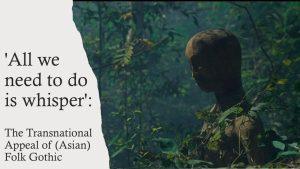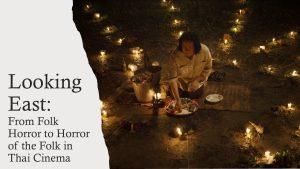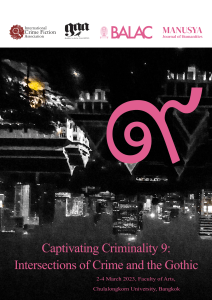
This page highlights some of my recent work and activities. For more information about my past and ongoing research, please explore the menu links. To make navigation easier, I have categorized my publications by themes and included links to article abstracts.
Haunting me, haunting you: Gothic parody and melodrama in Thai popular horror
Comic Gothic: An Edinburgh Companion, eds. Avril Horner and Sue Zlosnik, 2024
 Humour has always been an integral part of Thai horror, a cinematic genre characterized by its internal hybridity and fluidity. Despite some attempts to align local productions with Western or Japanese horror, the majority of Thai horror films continue to mix scares with laughter, frequently featuring the ‘unholy trinity’ of ghosts, slapstick comedy and the kathoey – a Thai third gender category, often depicted in such productions in terms of the Gothic body that is simultaneously the site of ridicule and fear. This article examines the work of two directors who have embraced this approach – Poj Arnon and Yuthlert Sippapak. While Poj Arnon’s films have often been branded as tasteless and nonsensical, each of his 30-something productions has made a healthy profit, attesting to their popularity. In contrast, Yuthlert Sippapak’s works have baffled audiences at several international festivals and the director himself has been promoted as an inscrutable auteur. This article focuses on two major film series by these directors – Hor Taew Tak by Poj Arnon, and Buppah Rahtree by Yuthlert Sippapak. The article uses these films to illustrate a distinction between Thai horror comedies and Thai popular horror films, arguing that the comic elements are an indispensable part of their Gothic framework and a feature characteristic of Thai popular horror film in general.
Humour has always been an integral part of Thai horror, a cinematic genre characterized by its internal hybridity and fluidity. Despite some attempts to align local productions with Western or Japanese horror, the majority of Thai horror films continue to mix scares with laughter, frequently featuring the ‘unholy trinity’ of ghosts, slapstick comedy and the kathoey – a Thai third gender category, often depicted in such productions in terms of the Gothic body that is simultaneously the site of ridicule and fear. This article examines the work of two directors who have embraced this approach – Poj Arnon and Yuthlert Sippapak. While Poj Arnon’s films have often been branded as tasteless and nonsensical, each of his 30-something productions has made a healthy profit, attesting to their popularity. In contrast, Yuthlert Sippapak’s works have baffled audiences at several international festivals and the director himself has been promoted as an inscrutable auteur. This article focuses on two major film series by these directors – Hor Taew Tak by Poj Arnon, and Buppah Rahtree by Yuthlert Sippapak. The article uses these films to illustrate a distinction between Thai horror comedies and Thai popular horror films, arguing that the comic elements are an indispensable part of their Gothic framework and a feature characteristic of Thai popular horror film in general.
“All We Need to Do is Whisper”: The Transnational Appeal of (Asian) Folk Gothic
Gothic Trans/Iterations. 17th IGA Conference, 30/07- 2/08/2024, Halifax, Nova Scotia, Canada
 Folklore has always been integral to Asian Horror but in recent years we have seen a more enthusiastic engagement with folklore themes and animist motifs. This coincides with the global revival of folk horror and can be seen as an attempt to emulate this genre. But while, intuitively, it is fair to assume that folk horror is a category not limited to western cinema, any attempt to seek Asian versions of folk horror require a considerable revision of its existing definitions. This paper draws on Dawn Keetley’s excellent discussion of Folk Gothic and argues that folk Gothic provides a much better paradigm for Asian horror films than folk horror. Keetley’s claim that ‘Folk Gothic is defined by particular temporal and spatial relations that serve to shape non-human stories’ which ‘tilt towards land and objects’ (2023, 9-10) resonates particularly well with the animist framework of East and Southeast Asian horror productions, where nature is alive with spirits, and animist spaces and temporalities unsettle human exceptionalism. This paper reads a few such recent productions – Takashi Shimizu’s Haunted Village trilogy (2019-2022, Japan), Emir Ezwan’s Roh (2019, Malaysia), Kevin Ko’s Incantation (2022, Taiwan) and Taweewat Wantha’s Tee Yod (2023, Thailand) as examples of Asian Folk Gothic and the markers of a new transnational trend in Asian Horror. The article argues that folk Gothic is well attuned to the animist sensibilities of these films where ‘the folk’ are often non-human.
Folklore has always been integral to Asian Horror but in recent years we have seen a more enthusiastic engagement with folklore themes and animist motifs. This coincides with the global revival of folk horror and can be seen as an attempt to emulate this genre. But while, intuitively, it is fair to assume that folk horror is a category not limited to western cinema, any attempt to seek Asian versions of folk horror require a considerable revision of its existing definitions. This paper draws on Dawn Keetley’s excellent discussion of Folk Gothic and argues that folk Gothic provides a much better paradigm for Asian horror films than folk horror. Keetley’s claim that ‘Folk Gothic is defined by particular temporal and spatial relations that serve to shape non-human stories’ which ‘tilt towards land and objects’ (2023, 9-10) resonates particularly well with the animist framework of East and Southeast Asian horror productions, where nature is alive with spirits, and animist spaces and temporalities unsettle human exceptionalism. This paper reads a few such recent productions – Takashi Shimizu’s Haunted Village trilogy (2019-2022, Japan), Emir Ezwan’s Roh (2019, Malaysia), Kevin Ko’s Incantation (2022, Taiwan) and Taweewat Wantha’s Tee Yod (2023, Thailand) as examples of Asian Folk Gothic and the markers of a new transnational trend in Asian Horror. The article argues that folk Gothic is well attuned to the animist sensibilities of these films where ‘the folk’ are often non-human.
Here be Monsters: What can Asia teach us about Gothic?
Plenary Lecture, Progression, Regression, and Transgression in Gothic World Literature & Film:
New Approaches to the Ethics of Difference, Gothic without Borders online conference, 29/09-2/10/2023
 Gothic narratives have often depicted Asia as the land of monsters, yet Asian monsters themselves have rarely received the attention they deserve. With countless books theorizing vampires, werewolves and zombies, Asian monsters continue to be seen as an oddity, evading definitions and complicating our understanding of monstrosity. Evoking fear, familiarity, and reverence in equal measure, Asian monsters can be simultaneously Gothic and anti-Gothic. Like all monsters, they do cultural work, and in this lecture, I will discuss three specific cases that can help me address a larger relationship between Asian Gothic and Gothic Studies in general.
Gothic narratives have often depicted Asia as the land of monsters, yet Asian monsters themselves have rarely received the attention they deserve. With countless books theorizing vampires, werewolves and zombies, Asian monsters continue to be seen as an oddity, evading definitions and complicating our understanding of monstrosity. Evoking fear, familiarity, and reverence in equal measure, Asian monsters can be simultaneously Gothic and anti-Gothic. Like all monsters, they do cultural work, and in this lecture, I will discuss three specific cases that can help me address a larger relationship between Asian Gothic and Gothic Studies in general.
Looking East: From Folk Horror to Horror of the Folk in Thai Cinema
Digital Lecture, Folk Horror series, organised by The Last Tuesday Society, 14/12/2023
 Folk horror is often said to be about the fear of regression, the fear of going back to ‘the old ways’ and the anxiety that ‘the old ways’ may be right. But what if the old ways and the new ways were very much the same? How does folk horror adapt to animist cultures, where old-age rituals and modern beliefs go hand in hand? Where does it find its ‘monstrous tribe’? Thai horror films reflect the animist orientation of Thai culture but do not situate animism in opposition to official religion and modernity, since animistic beliefs and practices are commonplace in today’s Thailand. Prevalent across the country and practised across all social strata, Thai animism and related with it folklore cannot be used as a designator of difference in the Thai context. If Thai folk horror produces its monstrous tribe, their monstrosity is not the result of regression, evidenced in arcane rituals, but rather a commentary on the existing inequality within Thai society. Thai folk horror is thus primarily invested in representing the rural-urban divide and its profound implication in tensions related to ethnicity and class.
Folk horror is often said to be about the fear of regression, the fear of going back to ‘the old ways’ and the anxiety that ‘the old ways’ may be right. But what if the old ways and the new ways were very much the same? How does folk horror adapt to animist cultures, where old-age rituals and modern beliefs go hand in hand? Where does it find its ‘monstrous tribe’? Thai horror films reflect the animist orientation of Thai culture but do not situate animism in opposition to official religion and modernity, since animistic beliefs and practices are commonplace in today’s Thailand. Prevalent across the country and practised across all social strata, Thai animism and related with it folklore cannot be used as a designator of difference in the Thai context. If Thai folk horror produces its monstrous tribe, their monstrosity is not the result of regression, evidenced in arcane rituals, but rather a commentary on the existing inequality within Thai society. Thai folk horror is thus primarily invested in representing the rural-urban divide and its profound implication in tensions related to ethnicity and class.
Captivating Criminality 9: Intersections or Crime and the Gothic
Conference organiser
 The first Asian Captivating Criminality conference of the International Crime Fiction Association [ICFA] organised in cooperation with the Gothic in Asia Association [GAA], the BALAC Programme of the Faculty of Arts, Chulalongkorn University and Manusya, Journal of Humanities
The first Asian Captivating Criminality conference of the International Crime Fiction Association [ICFA] organised in cooperation with the Gothic in Asia Association [GAA], the BALAC Programme of the Faculty of Arts, Chulalongkorn University and Manusya, Journal of Humanities
Bangkok, 2-4 March 2023 and online
